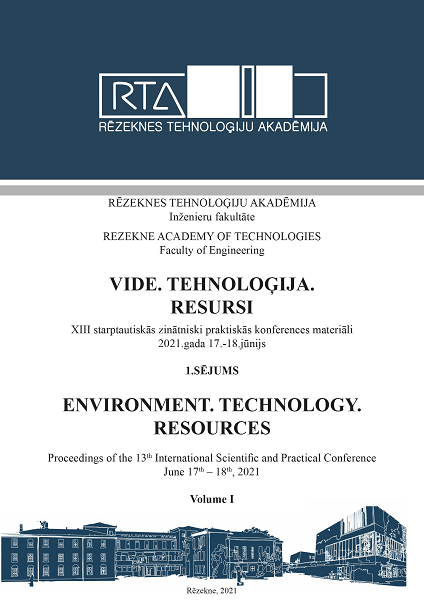SEASONAL DYNAMICS OF PHYTOPLANKTON AND SOME HYDROCHEMICAL INDICATORS OF THE PEIPSI-PSKOV LAKE
DOI:
https://doi.org/10.17770/etr2021vol1.6557Keywords:
environmental monitoring, hydrochemical indicators, Peipsi-Pskov Lake, phytoplanktonAbstract
The Peipsi-Pskov Lake is the largest freshwater body in Europe, ranking fourth in area and fifth in volume. It is characterized by shallow water and a high level of trophy. The water in the lake is poorly mineralized and has little transparency due to suspended sediments and the development of plankton. Phytoplankton acts as a primary link in trophic chains, quickly reacts to changes in the aquatic environment and serves as a convenient object in monitoring studies.
The average concentrations of total nitrogen in the lake during the observation period were in the range of 525-818 µg/dm3. The content of ammonium, nitrate, and nitrite nitrogen in the samples was mostly below the detection limits. The values of total phosphorus varied from 20 µg/dm3 to 54 µg/dm3, and its concentrations were lower than the sensitivity of the method during the flood recession.
The maximum values of total nitrogen and phosphorus were recorded in August: in Lake Peipsi - 1.12 mg/dm3 and 0.09 mg/dm3, in Lake Pskov - 1.59 mg/dm3 and 0.14 mg/dm3, respectively. BOD5 values ranged from 1.96 mg/dm3 in autumn to 4.26 mg/dm3 in summer.
During the growing season of 2020, 244 species taxa of phytoplankton from 8 phylums were identified in the Peipsi-Pskov Lake: Chlorophyta, Bacillariophyta, Cyanobacteria, Chrysophyta, Euglenophyta, Cryptophyta, Dinophyta and Xanthophyta. Floristic complex was characterized as сhlorophyta-diatom-cyanobacterial.
The number of phytoplankton varied between 2.1 and 16.2 million cells/l depending on the season. The average number was 7.6 million cells/l. The biomass values ranged from 0.9 g/m3 to 3.6 g/m3. The average biomass was 2.3 g/m3.
According to the ecological and geographical characteristics of the lake, widespread freshwater forms of microalgae predominated, preferring stagnant-flowing, slightly alkaline waters.
Saprobiological analysis showed that the waters of the Peipsi-Pskov Lake were classified as moderately polluted, class III of water purity quality.
Downloads
References
Pskov-Peipsi Lake. T. Timm, A. Raukas, Yu. Khaberman, A. Yaani, Ed. Tartu: Eesti Loodusfoto, 2012.
G. T. Frumin, N. A. Malysheva, "Water quality changes in Lake Pskovskoe (2000–2018)," Transactions of Karelian Research Centre of Russian Academy of Science, Limnology, no. 4, pp. 32-39, 2020.
V. A. Rumyantsev, V. G. Drabkova, A. V. Izmailova, Lakes of the European part of Russia. St. Petersburg: LEMA, 2015.
T. V. Drozdenko, S. G. Mihalap, "Structural and taxonomic diversity and ecological features of phytoplankton in the Velikaya River (Pskov region)," Vestnik Tomskogo gosudarstvennogo universiteta. Biologiya, no. 41, pp. 118-134, 2018, https://doi.org/10.17223/19988591/41/7
A. Basset, G. C. Carrada, M. Fedele, L. Sabetta, "The equilibrium concept in phytoplankton communities.," Encyclopedia of Ecology, Vol. 2, pp. 1394-1402, August 2008. [Abstract]. Available: ProQuest, http://www.umi.com/proquest/, [Accessed January 15, 2021], https://doi.org/10.1016/B978-008045405-4.00711-4
C. Liu, C. Liu, H. Shen, "Seasonal variations of phytoplankton community structure in relation to physico-chemical factors in Lake Baiyangdian, China," Procedia Environmental Sciences, vol. 2, pp. 1622-1631, December 2010. Available: ProQuest, http://www.umi.com/proquest/, [Accessed January 15, 2021], https://doi.org/10.1016/j.proenv.2010.10.173
N. Zivana, M. Buzancic, G. Kuspilic, B. Grbec, S. Matijevic, S. Skejic, I. Marasovic, M. Morovic, "The response of phytoplankton community to anthropogenic pressure gradient in the coastal waters of the eastern Adriatic Sea," Ecological Indicators. vol. 56, pp. 106-115, September 2015. Available: ResearchGate, https://www.researchgate.net/ [Accessed January 15, 2021], https://doi.org/10.1016/j.ecolind.2015.03.018
I. S. Trifonova, Ecology and succession of lake phytoplankton. Leningrad: Nauka, 1990.
A. P. Sadchikov, Methods of studying freshwater phytoplankton: methodological guidelines. Moskow: Universitet i shkola, 2003.
GOST 31861-2012. Water. General requirements for sampling. Moscow, 2014.
Environmental normative document (Federal)14.1:2:4.3-95 Methods of measurement of mass concentration of nitrite ions in drinking water, surface water and sewage of photometric method with Griess reagent. Moscow, 1995 (edition 2011).
Environmental normative document (Federal)14.1:2:4.4-95 Methods of measurement of mass concentration of nitrate ions in drinking water, surface water and sewage of photometric method with salicylic acid. Moscow, 1995 (edition 2011).
Environmental normative document (Federal) 14.1:2:4.50-96 Methods of measuring the total mass concentration of total iron in drinking water, surface water and sewage of photometric method with sulfosalicylic acid. Moscow, 1996 (edition 2011).
Environmental normative document (Federal) 14.1:2:4.112-97 Methods of measurement of mass concentration of phosphate ions in drinking water, surface water and sewage by the photometric method with ammonium molybdate. Moscow, 1997 (edition 2011).
Environmental normative document (Federal)14.1:2:3:4.123-97 Methods of measurement of the biochemical oxygen demand after the n-days of incubation (BOD full) in surface freshwater, groundwater, drinking water, sewage and effluent sewage. Moscow, 1997 (edition 2004).
Environmental normative document (Federal) 14.1:2:4.276-2013 Methods of measurement of the mass concentration of ammonia and ammonium ions in drinking water, natural water and sewage by photometric method with Nessler reagent. Moscow, 2013.
Methods of studying biogeocenosis of inland water bodies. F. D. Mordukhay-Boltovskiy, Ed. Moscow: Nauka, 1975.
V. M. Shmidt, Statistical methods in comparative floristics. Leningrad: Leningradskiy universitet, 1980.
F. Pantle and H. Buck, "The biological monitoring of the waters and the presentation of the results" in Gas and water compartment, Bd 96, № 18, 1955, pp. 604-618.


